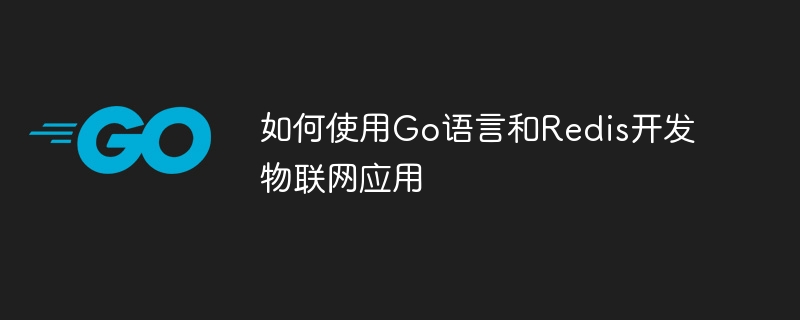Home >Backend Development >Golang >How to develop IoT applications using Go language and Redis
How to develop IoT applications using Go language and Redis
- WBOYWBOYWBOYWBOYWBOYWBOYWBOYWBOYWBOYWBOYWBOYWBOYWBOriginal
- 2023-10-27 16:10:411140browse

How to use Go language and Redis to develop IoT applications
With the rapid development of IoT technology, more and more devices are able to connect and communicate through the Internet. This allows us to manage and monitor various equipment through a central control system. In the development process of IoT applications, the use of efficient database systems is very critical. This article will introduce how to use Go language and Redis to develop Internet of Things applications, and provide specific code examples.
Redis is a high-performance key-value storage database suitable for processing read and write operations of large amounts of data. It supports a variety of data structures, such as strings, lists, hash tables, and sets, and provides a rich set of commands for operating on data. In IoT applications, we can use Redis to store device information, sensor data, control instructions, etc.
First, we need to install and configure the Redis database. You can download and install the latest version of Redis from the Redis official website (http://redis.io). After the installation is complete, we need to start the Redis server and use the redis-cli command line tool to manage and operate the Redis database.
Next, we use Go language to develop Internet of Things applications. First, you need to install the redis.go package in the Go environment. You can use the following command to install it:
go get github.com/gomodule/redigo/redis
Then, import the redigo package in the Go code:
import "github.com/gomodule/redigo/redis"
The following is an example using the Go language Example of developing IoT applications with Redis:
package main
import (
"fmt"
"github.com/gomodule/redigo/redis"
)
func main() {
// 连接Redis数据库
conn, err := redis.Dial("tcp", "localhost:6379")
if err != nil {
fmt.Println("连接Redis失败:", err)
return
}
defer conn.Close()
// 存储设备信息
deviceID := "device001"
deviceInfo := map[string]string{
"name": "设备1",
"status": "在线",
}
_, err = conn.Do("HMSET", redis.Args{}.Add("device:"+deviceID).AddFlat(deviceInfo)...)
if err != nil {
fmt.Println("存储设备信息失败:", err)
return
}
fmt.Println("存储设备信息成功")
// 获取设备信息
device, err := redis.StringMap(conn.Do("HGETALL", "device:"+deviceID))
if err != nil {
fmt.Println("获取设备信息失败:", err)
return
}
fmt.Println("设备信息:", device)
// 存储传感器数据
sensorID := "sensor001"
sensorData := map[string]interface{}{
"temperature": 25.2,
"humidity": 60.5,
}
_, err = conn.Do("HMSET", redis.Args{}.Add("sensor:"+sensorID).AddFlat(sensorData)...)
if err != nil {
fmt.Println("存储传感器数据失败:", err)
return
}
fmt.Println("存储传感器数据成功")
// 获取传感器数据
data, err := redis.Float64(conn.Do("HGET", "sensor:"+sensorID, "temperature"))
if err != nil {
fmt.Println("获取传感器数据失败:", err)
return
}
fmt.Println("传感器温度数据:", data)
}In this example, we first connect to the Redis database and use the HMSET command to store device information and sensor data. Then obtain device information and sensor data through HGETALL and HGET commands. Finally, we output the obtained device information and sensor data.
Through the above examples, we can see how to use Go language and Redis to develop Internet of Things applications. Through the rational use of databases, information and data from IoT devices can be managed and operated more efficiently. Of course, in practical applications, it also needs to be expanded and optimized according to specific needs.
In summary, with the help of Go language and Redis, we can easily develop IoT applications and have high-performance and high-reliability data storage and processing capabilities. I hope this article can help you understand how to use Go language and Redis to develop IoT applications.
The above is the detailed content of How to develop IoT applications using Go language and Redis. For more information, please follow other related articles on the PHP Chinese website!

